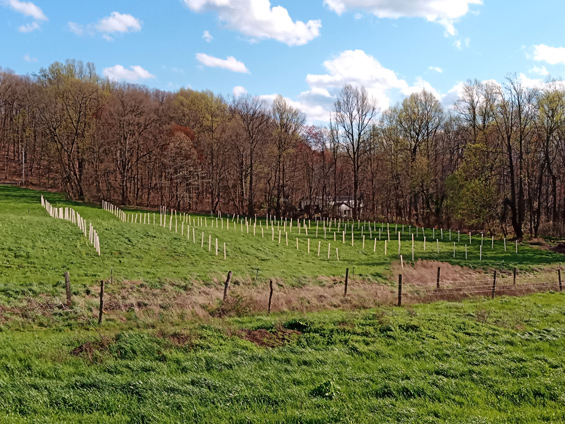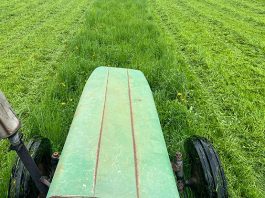
As someone who spends a lot of time talking with farmers about planting trees, there’s a certain phrase I’ve heard more than I can count. “Why in the world would someone do that? My granddad spent years clearing the woods so we can farm.”
If you’re reading a grazing publication, I’ll assume you’re a bit more open to new ideas than the typical corn-and-bean farmer. If you’ve converted to grass-fed livestock, chances are your neighbors already think you’re a bit loony. But to plant trees in that pasture? You’d be nuts!
If you have some hesitations about planting trees (not least because several ancestors would roll over in their graves), that’s normal. But here’s the deal: These ain’t your grandpa’s trees. If the trees your grandpa cleared were a rusty jalopy sitting out back with a broken axle, what you can now plant is more akin to a shiny F-150. We’re not talking planting random trees at random places and crossing our fingers that they’ll survive. We’re talking planting the right species with the right genetics in the right places in a way that will compliment your farm.

When thinking about what trees can do for a farm, I like to think about two paths that people can go down. On the one hand, we can plant trees that will add new enterprises to the farm. Here we’re talking about growing timber, fruits or nuts. Planting pecans or English walnuts for their nuts, apples for cider, or black walnuts and black locust for timber. Each one will allow you to diversify the farm operation and develop new income streams.
The other path is to choose trees that will strengthen your current livestock operation. Whether you raise dairy or beef or sheep or hog or poultry or alpacas, you can plant trees that will make what you already do more profitable and resilient. We do this by planting trees that will provide the shade, fodder, windbreak, and nitrogen that will keep your livestock healthier, more comfortable, and better fed than could be done with pasture alone.

Of course, these two paths don’t have to be mutually exclusive. You can focus on adding trees to serve your livestock while also planting a patch of heartnuts or chestnuts. Just keep in mind that planting fruit and nut trees across the whole farm for commercial yield is a whole other game than planting for home use alone.
What is certain is this: When adding trees to pasture, the low-hanging fruit is not fruit (or nuts). The easiest place to start is to hone in on those trees that will take your grazing management up a level. Plant persimmons to drop high-energy fruits packed with vitamins in the fall. Plant black locust to fix nitrogen while letting nice dappled shade cool your livestock and forages. Best yet, plant honey locust for a complete package of nitrogen fixation, light canopy and calorie-packed pods dropped from October through December.
 If you already have your hands full and don’t foresee more folks joining the farm business, this is a great place to stop. However, if junior is coming up and wants a role on the farm, or you want the farm to support multiple families, adding trees for saleable crops is vertical integration of a business in the most literal sense. Joel Salatin would call it stacking fiefdoms, and in this case, we’re actually stacking one farm enterprise above the existing one. You’ll need to go into it wide-eyed about the investments you’ll need to make in order to harvest, process and market your wares, as well as being conscious about food-safety regulations, but thankfully there’s a growing body of information to help you make those decisions. If you’re interested, I would suggest getting the Perennial Pathways guide from the Savanna Institute.
If you already have your hands full and don’t foresee more folks joining the farm business, this is a great place to stop. However, if junior is coming up and wants a role on the farm, or you want the farm to support multiple families, adding trees for saleable crops is vertical integration of a business in the most literal sense. Joel Salatin would call it stacking fiefdoms, and in this case, we’re actually stacking one farm enterprise above the existing one. You’ll need to go into it wide-eyed about the investments you’ll need to make in order to harvest, process and market your wares, as well as being conscious about food-safety regulations, but thankfully there’s a growing body of information to help you make those decisions. If you’re interested, I would suggest getting the Perennial Pathways guide from the Savanna Institute.
Your grandpa never really had the opportunity to plant trees this way. The information and support and genetics and resources were just so much tougher to come by. Yet if he had pulled it off somehow, you might now have a farm with towering honey locusts feeding the herd through the winter, hybrid oaks for fattening hogs, and apples for pressing into cider. Today, the resources and support and information are all available, ready for you to take grazing up a level.
Next week, Austin writes about tree planting techniques that can survive livestock grazing in the same pasture.





Your advice seems very practical to me. It is encouraging to know that a silvopasture practice does not necessarily need to emphasize commercial tree product production.
I don’t think that approach pencils out for small farms and harvesting fruit and nuts where animals graze could be difficult to manage because of food safety laws.
Planting trees to strengthen a livestock operation makes sense for the reasons you mention. Is there any practical way to place a monetary value on the shade, sheter, forage, nitrogen, flood mitigation, and beauty trees provide to a livestock grazing system?
Hi Emily,
That’s a really good question. I’d say some of that research has been done, but it’s going to vary so much depending on the setting (especially the value of flood mitigation, water quality, beauty, etc).
The best study I’ve seen in this space looked at the economic returns of honeylocust in a silvopasture setting. In the article they estimate that the returns on the investment in trees would be between 9% and 24%. Even 9% is a great return on investment, and 24% is super high. And that only factored in the feed value of the pods, saying nothing about heat stress reduction or windbreak or nitrogen fixation.
One of these days I’ll get around to breaking down the numbers for the other factors as well.
Here’s that article about the return on investment for honeylocust: https://pubs.cif-ifc.org/doi/pdfplus/10.5558/tfc67232-3
Great timing for this series! I have 30 acres of hillside pasture I’d like to sprinkle with some more trees.
Good to hear Cindy. Feel free to reach out if you want to talk through your options.
austin@crowandberry.com
Water represents the most limiting factor in grass growth almost always and it’s a zero-sum deal. Whatever water trees use becomes unavailable for grass or other uses.
Hey Luke,
You’re absolutely right that water is a huge limiting factor, in some areas more than others.
There are a lot of things going on when trees and pasture interact. Like you noted, there’s the belowground competition for water. There’s also shading from the trees, which will reduce heat stress and transpiration for forages. There’s the effect called hydraulic lift, where deep-rooted trees can pull water from deep soil horizons and make it available at shallower levels where neighboring plants can take advantage of it. And integrating trees into a well-managed system should boost soil biology and organic matter, thus boosting water holding potential.
How things balance out will depend on your site and climatic conditions, and to a large extend on which trees are selected.
Below is a link to a 2019 overview of silvopasture, including forage production and livestock performance. It’s the most complete scientific overview of silvopasture research I’ve found:
https://link.springer.com/content/pdf/10.1007%2Fs10457-019-00366-8.pdf
Comments are closed.